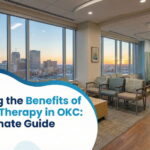Good mental health is crucial to have a good personal and professional life. People face mental issues like depression, anxiety, and mental fatigue due to different reasons. It could be relationship issues or some kind of emotional trauma that causes a decline in mental health. It is vital to know that different communities across the world also suffer due to mental illness.
Racism against people of different colors and creeds is the biggest cause of mental health issues in the US and other parts of the world. Research studies show that a large number of people in the US who reported poor mental health were Asian, Black, or Hispanic.
Many human rights organizations celebrated July as the month of “Minority Mental Health,” but now they have switched to a different title. It has been replaced by the “BIPOC (Black, Indigenous, and People of Color)” to address the mental health struggles of different groups. Due to this, healthcare experts have also become able to assess the relationship between different communities and mental health care.
Let’s find out more about mental health issues faced by BIPOC.
1- Racism and Injustice
One of the most common issues that BIPOC faces is injustice and racism, which has a long history, especially in the history of the US.
According to a statistical study, African Americans are 20% more likely to suffer due to mental disorders than the general population.
Therefore, it is crucial for any individual, whether Black or Asian, to consult the relevant treatment center. There have been groups like BIPOC and The Counseling Center Group for such issues. They have great experience in dealing with such cases where people face mental or emotional trauma due to racial discrimination.
2- Internal Stigma of Mental Health
Different research studies have shown that marginalized communities have mental health stigma, which prevents them from getting professional help. For example, African Americans have a long history of resilience as they have faced slavery, so dealing with sadness or anxiety is not an issue. The problem appears when someone fails to recognize the mental illness or faces hesitation to talk about it.
In such situations, the fear of getting judged due to mental illness based on skin color or race can be the biggest obstacle. Some of the communities see mental health issues as personal failures rather than treatable conditions.
3- Not Having Access to Good Care
In the BIPOC community, not many people have access to high-quality care, which leads to mental health issues. If you do not take timely steps to prevent depression or anxiety, it can take a toll on your mental health and can be a threat to your physical health too.
According to a research study, in 2020, 37.1% of Black people got mental health treatment. Also, the language barrier in communication can be challenging for the BIPOC community. A high number of people in the BIPOC community do not speak English, so it makes it really difficult for them to express themselves in a country like the US.
Access to quality mental health care is limited for many native communities. Another research study revealed that 17.7% of Hispanics in the US had no health insurance as compared to White adults. They mostly depend on public coverage or Medicaid, so limited access is one of the major reasons for the poor mental health in the BIPOC community, which needs to be addressed.
4- Lack of Diversity Creates Gap
One of the major causes of mental distress in the BIPOC community is that most of the care providers in the US are white.
According to a statistical study, in 2015, around 86% of psychologists were White. A similar study showed that only 2% of psychologists were Black. This lack of diversity leads to a significant gap in understanding between patients and providers.
It is difficult for mental health experts who do not belong to the BIPOC community to address the relevant issues. Because they can not relate to their lived experiences, they can not understand the impact of discrimination on the mental health of individuals. Eventually, it affects the quality of treatment.
5- Socioeconomic Factors
Socioeconomic disparities are one of the major causes of the lack of availability of treatment options for the BIPOC community. It was revealed in 2018 that 11.5% of Black adults had no health insurance in the US.
Also, the Black community is more likely to suffer due to socioeconomic disparities and face exclusion from health, social, and economic resources. Eventually, this lack of equality leads to worse mental health outcomes.
6- Demographics Issues and Cultural Factors
Demographic issues are another major cause of declining mental health in the BIPOC community. Around 1.3% of the US population is of Alaska Native heritage, and they speak over 200 languages. It creates a communication barrier and makes it difficult to get access to mental health care services.
A large number of native people in the US live in the Western states. Two-thirds of the population now live in urban and suburban areas, so it also makes it difficult to get access to quality care facilities.
It has been estimated that 26.6% of Native Americans live in poverty. Financial instability and unemployment also negatively impact the mental health of individuals. All these factors collectively lead to mental distress, so it is crucial for the relevant government bodies to address the issues in relevant states.
Conclusion
It is crucial for BIPOC who goes through mental health issues to get timely help from the relevant treatment center and healthcare experts. Whether you are Hispanic or Black, you must get the treatment to get rid of mental disorders, so you can focus on your professional and personal life. It will help you excel in your life and also make a positively contribute to the lives of others.
On the other hand, a huge responsibility lies on the relevant healthcare and government organizations to take notice of the mental health issues of the BIPOC community. These issues can not be resolved until relevant government bodies will not take the right initiatives for the betterment of oppressed communities.
Read Also
- Exploring the Benefits of Infusion Therapy in OKC: The Ultimate GuideUnderstanding Infusion Therapy: A Deep Dive into Its Purpose and Process What exactly is Infusion Therapy? Infusion therapy is an advanced medical treatment that delivers medication and nutrients directly into the bloodstream through a vein, typically via an IV (intravenous) line. This method is particularly beneficial for patients who require a concentrated dose of medication,… Read more: Exploring the Benefits of Infusion Therapy in OKC: The Ultimate Guide
- Ketamine-Assisted Therapies: Impacts on Employee WellbeingWorkplace stress is common today. Many employees feel tired, anxious, or burned out. Regular therapy can help, but some people need more support. Ketamine-assisted therapy is showing good results for mental health. A ketamine-assisted therapist guides each session safely. This therapy can improve mood, focus, and energy. Learning more about it can help teams stay… Read more: Ketamine-Assisted Therapies: Impacts on Employee Wellbeing
- The Future of Men’s Health: Why Telehealth Is Here to StayTelehealth isn’t just a pandemic trend that faded into the background. For Australian men, it has become one of the most practical, time-saving, and stress-free ways to manage everyday health — and it’s shaping the future of how we access care. Platforms like DOCTO, an Australian online doctor and specialist telehealth service, are leading the… Read more: The Future of Men’s Health: Why Telehealth Is Here to Stay
- How to Build a Simple, Clean Skincare Routine ?You don’t need a complicated skincare routine. It doesn’t have to be something that requires twenty different products and confusing steps. Your routine works well with just a few high-quality clean ingredients. The beauty industry keeps pushing more products, but your skin actually needs less. You only need a simple approach to get better results… Read more: How to Build a Simple, Clean Skincare Routine ?
- How Preventive Dental Care Supports Overall HealthHave you ever wondered how a simple dental checkup could impact your entire body? Oral health is more than just a bright smile. Studies show that poor dental habits can contribute to serious health problems. Gum disease and tooth decay are linked to heart disease, diabetes, and infections. Yet, many people overlook preventive dental care.… Read more: How Preventive Dental Care Supports Overall Health
- Seeing Clearly in a High-Tech World: A Deep Dive into Advanced Vision Care ServicesProtecting your eyesight isn’t optional—it’s essential. Modern eye care has evolved far beyond basic exams, offering advanced diagnostics, personalized treatments, and surgical innovations that keep vision sharp for life. A leading example is Intermountain Eye Center, home to specialists like Dr Fishburn Boise, where patients receive comprehensive, high-level vision care designed to preserve long-term eye… Read more: Seeing Clearly in a High-Tech World: A Deep Dive into Advanced Vision Care Services







